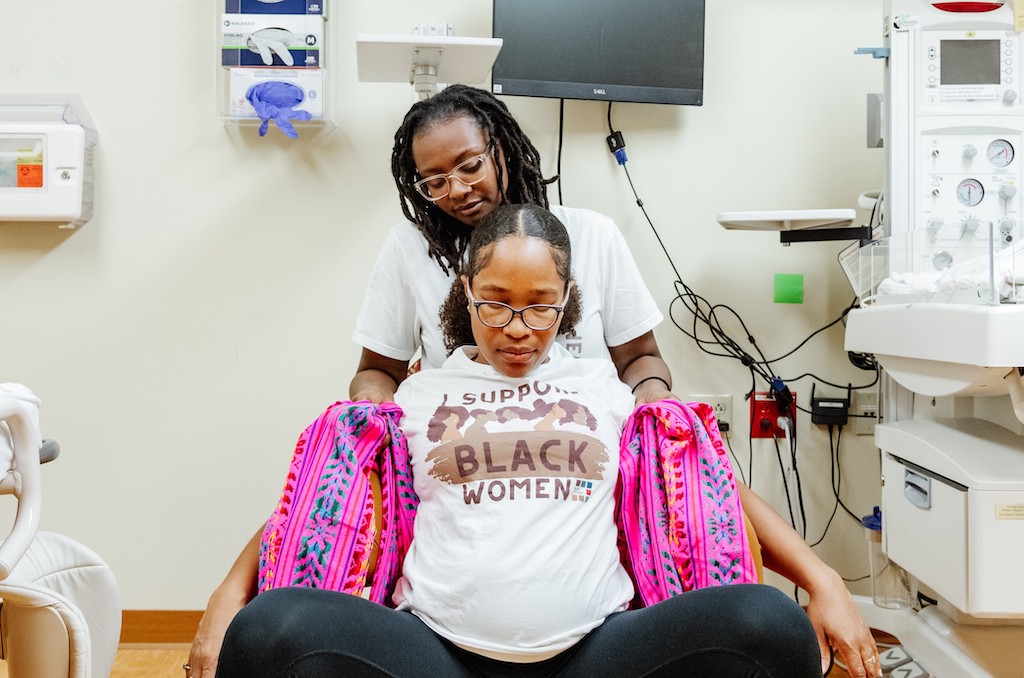11:45
News Story
To close racial gap in maternal health, some states take aim at ‘implicit bias’

Dana Williams, top, and Khalyson McDuffie, doulas with Birth in Color, a Virginia group that offers doula services for pregnant patients of color and training for local maternal health care workers to combat racial bias, participate in a doula simulation training session. Some states are mandating implicit bias training (Courtesy of Kenda Sutton-El/Birth in Color)
Countless times, Kenda Sutton-El, a Virginia doula, has witnessed her Black pregnant clients being dismissed or ignored by clinicians.
One woman was told by doctors that swelling, pain and warmth in her leg was normal, despite warning the clinicians that she had a history of blood clots. Sutton-El urged her to visit the emergency room. Tests found the pregnant patient did indeed have a blood clot, a situation that can be deadly.
Some clients were told they weren’t doing enough to lose weight. After another client was treated dismissively when she paid for a visit in cash, Sutton-El posed as a patient and got the same response, making her wonder how many other Black women had been treated the same way.
“The biggest thing is that they’re not being listened to,” said Sutton-El, founder of Birth in Color, a nonprofit that offers doula services to expecting Virginians. Doulas support and advocate for pregnant patients. “They’re being dismissed or [clinicians] act as if the pain isn’t there, or act as if the issue is normal, when it’s not.”
As the United States contends with stark racial disparities in maternal health, experts are pushing states to mandate training for medical professionals to combat “implicit bias,” the prejudiced attitudes a person might hold without being aware of it. Lawmakers in more states are heeding that call.
Since 2019, at least five states (California, Delaware, Maryland, Minnesota and New Jersey) have enacted laws mandating implicit bias training for maternal health care providers, according to Stateline research and an analysis by researchers at the University of California, San Francisco. Lawmakers in at least 20 other states have introduced legislation related to implicit bias training for general health care professionals.
Virginia lawmakers recently approved similar legislation, sending it to Republican Gov. Glenn Youngkin. He has not said whether he will sign it.
The training can take different forms. Some courses are offered online, while others can be one-day workshops. Participants typically examine certain scenarios and learn about the history and harms of racial stereotypes.
Sutton-El argues that the training can make a huge difference. She said that one white doctor who completed the training recently told her how it had influenced his treatment of a Black patient. She recalled him telling her: “I had your voice in my head that said, ‘Follow the patient down the rabbit hole, because you’ll find out what’s the real issue.’”
But others say implicit bias training can be insufficient or ineffective. Okunsola Amadou, a doula who founded Jamaa Birth Village, a midwifery clinic and maternal health nonprofit in Ferguson, Missouri, said bias trainings alone can’t change a hospital’s culture.
“The ultimate problem with that is that it is barely the surface,” Amadou said. “If they’re not working with [Black maternal health] pioneers who are rooted in this work to help them restructure, then the ‘click-and-go’ implicit bias trainings will not hold any weight at all.”
Tiffany Green, an associate professor at the School of Medicine and Public Health at the University of Wisconsin-Madison, said her team’s review of studies on anti-bias trainings in clinical settings found little evidence that it led to long-term behavioral changes.
Because racism isn’t just an individual problem but a systemic one, Green said, institutions must combat bias at the organizational level. If done incorrectly, it can induce anger in white employees and exacerbate inequities, she said.
While there is evidence that providers’ racial stereotyping affects treatment, it’s not known whether or how bias trainings will impact pregnant patient health outcomes, she told Stateline.
Rachel Hardeman, health equity director at the University of Minnesota Center for Antiracism Research and a co-author of the study on Black and white doctors, developed the widely used “Dignity in Childbirth and Pregnancy” course offered online in states with training mandates, including California and Minnesota. For Minnesota, her team designed a course focused on bias against Indigenous women. She said the courses are designed for both clinicians and hospital management: “People who may not be directly involved in patient care in the day-to-day but are involved in making leadership decisions.”
Evidence of bias
There is ample research suggesting there is racial bias in health care.
Black women in the United States are nearly three times more likely to die of maternal health complications than white women, according to the most recent data from the U.S. Centers for Disease Control and Prevention. Indigenous women are nearly twice as likely to die.
Research has shown implicit racial bias plays a role in those stark disparities. Examples of that bias include false beliefs that Black patients have higher pain tolerance and thicker skin, as well as long-used diagnostic tools — such as lung and kidney function tests — that have prevented proper diagnoses for Black patients.
A CDC study published last year found that nearly 1 in 3 Black, Hispanic and multiracial women reported mistreatment during pregnancy and delivery, such as receiving no response to requests for help, being shouted at, or being threatened with the withholding of treatment.
Another review, also published last year, analyzed 42 studies since 2014 and concluded that racial biases and structural racism contributed to maternal health complications for Black women. And a 2020 study found Black infants were twice as likely to survive when cared for by Black doctors.
Research by Hardeman and others has found that clinicians are more likely to describe Black patients as “not compliant,” “agitated” or “aggressive.” When such descriptions are included in a patient’s medical record, it can color the perceptions of other providers who consult it, influencing their interactions with the patient.
Hardeman’s courses include patient anecdotes that illustrate bias as well as strategies for curbing assumptions and practicing more empathy. The courses also include a history of racism in medicine, such as the gynecological experiments by J. Marion Sims, often called the father of modern gynecology, on Black enslaved people.
Given that history, many Black, Indigenous and Hispanic patients are wary of health care systems.
“We’re talking about the fact that our medical education system has been built within this history of racism, and so we have to be aware of it to undo it,” Hardeman said.
“We wanted to make sure that people walked away understanding that we all have a role in dismantling these systems, and it starts with educating ourselves, and then making sure that what we’re learning and what we’ve been educated on, we’re applying it to the way that we are interacting with different patients and their families.”
Stalled legislation
But passage of a law doesn’t always lead to immediate change.
A year and half after California’s law took effect in 2020, a California Department of Justice investigation found just 17% of providers surveyed had trained their entire staff. Nearly a year after the probe began and more outreach was conducted, completed training rates rose to 81%. New legislation introduced this year aims to strengthen the law by fining health care centers that fail to train their staff, and would extend training requirements to nursing staff.
In many states, implicit bias legislation has stalled before reaching the governor’s desk.
In Missouri, a bill introduced in 2022 died in committee. State Rep. LaKeySha Bosley, a Democrat, reintroduced it this year. And in Georgia, lawmakers reintroduced this session a bill that would mandate implicit bias training for health care professionals in childbirth settings. Both of the reintroduced bills remain in committee.
Dr. Lethenia “Joy” Baker, an obstetrician and gynecologist in rural Georgia, often sees Black patients who specifically sought her out.
“[They] say, ‘I chose you, because you were the one Black woman in town, and I just feel more comfortable,’” she said. “We have to think about the fact that there’s such a lack of diversity in medicine,” making training for everyone important.
“We really need to unpack about the legacy of Southern slaves, and how we begin to move past that. So, I think that legislation is important around this topic, because let’s just face it, that legacy is very painful,” she said.
In South Carolina, Democratic state Rep. JA Moore and other Democrats have introduced implicit bias bills twice since 2020, but neither has passed. Moore said he plans to propose it again.
“I will continue to fight like hell,” Moore told Stateline, saying his aim is to address some of the “challenges so many women have, specifically minority women, low-income women have, in the state of South Carolina.”
South Carolina Black women were more than four times as likely as white women to die of maternal health complications in 2020, according to the state’s latest report. The state’s Morbidity and Mortality Review Committee found that discrimination contributed to more than a third of deaths from 2018 to 2020.
“This is just another way in which we can try to change those numbers,” Moore said. “[It’s] an opportunity to lead a dramatic change in these very horrific, disproportionately racialized health outcomes for so many citizens.”
Stateline is part of States Newsroom, a nonprofit news network supported by grants and a coalition of donors as a 501c(3) public charity. Stateline maintains editorial independence. Contact Editor Scott S. Greenberger for questions: [email protected]. Follow Stateline on Facebook and Twitter.
Our stories may be republished online or in print under Creative Commons license CC BY-NC-ND 4.0. We ask that you edit only for style or to shorten, provide proper attribution and link to our website. AP and Getty images may not be republished. Please see our republishing guidelines for use of any other photos and graphics.




